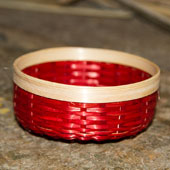.
Bamboo Craft - Wayanad
Once the culms are treated and split they are ready to be used in weaving. The thickness of the split bamboo depends on the need. Weaving is done either by hand or on looms. The women using various weaving techniques do hand weaving. These are done basically to make mats or to make baskets (kotta).
Curtains and blinds are weaved on frame loom. Reeds of longer length are used for weaving curtains or blinds. They are first dyed. Natural as well as synthetic dyes can be used for the purpose. After the sticks have dried they are ready for the loom. The weaving is done on frame looms. The warp can be plain undyed yarn purchased from the market or it can be dyed. After dyeing the yarn is opened or disentangled on the charkha and wound into small bundles. The next stage is warping, which takes place on a warping machine, an octagonal cylinder‐like frame. The thread rolls are first placed in a predetermined manner on a vertical frame. When the warping machine is rotated threads from these rolls pass through a reed frame and are wound on the cylinder, preparing the warp threads. Once the required length has been achieved the warp threads are transferred onto a beam on the loom for weaving.
The beam with the warp thread is placed on one end of the loom while the weaver sits at the other end at the level of the loom, with feet placed over the pedals or treadle. With one hand the weaver takes the hand‐shuttle across the warp to fill in the weft yarn. The reed is inserted through the hole and stretched across the warp yarn with the flat wooden bar. The beater with reed (comb‐like frame) is drawn with the other hand to beat the weft firmly into the warp. The movements are repeated to weave the desired product. As the mat is woven, it is wound onto a beam placed near the foot of the weaver.
Once the weaving is done, it is taken off the loom for further finishing. The curtain or blind is painted with chemical colors to further prevent it from moisture and sunlight. The sides of the curtains are cut and stitched with nylon strips. Fixtures for hanging are added. The product is checked finally and then packed.
Weaving of curtains and blinds majorly happens in URAVU, whereas baskets and mats are weaved by the women in their home.













